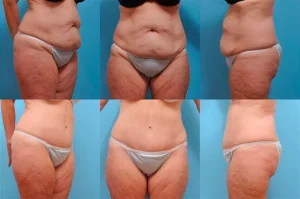What is Gynecomastia, the 7 Types its Causes and Treatments
Gynecomastia, commonly known as enlarged male breasts, is characterized by excessive gland and breast tissue growth in males. Approximately 36% of young and 57% of adult males have this condition. It can be physically and emotionally distressing for males, as it can cause self-consciousness, embarrassment, and a negative impact on their self-esteem.
Causes of Gynecomastia
Several factors can contribute to gynecomastia in men.
High Levels of Estrogen
An imbalance of hormones, specifically estrogen and testosterone, are a common cause. Although both males and females have these hormones, estrogen is typically more dominant in females, while testosterone is more dominant in males. Therefore, in cases of gynecomastia, the balance between these hormones is disrupted, increasing breast tissue.
Natural Hormonal Changes
One of the common causes during puberty in males is hormonal imbalance, as hormonal changes during this stage of life can cause temporary breast enlargement.
In addition, hormonal imbalances can also be caused by certain medical conditions such as liver disease, kidney disease, hormonal disorders, and tumors in males of all ages.
Medications
Medications such as anabolic steroids, anti-androgens, and some medicines used to treat prostate cancer, can also contribute to this condition.
Lifestyle Habits
Lifestyle can be a significant factor. Obesity, excessive alcohol consumption, and marijuana use have been associated with an increased risk of developing gynecomastia.

Types of Gynecomastia
Normal Gynecomastia
Normal gynecomastia usually presents as a bilateral (affecting both breasts) and symmetrical enlargement of breast tissue that is soft, mobile, and typically painless. It does not usually cause other symptoms and is generally benign. However, it may cause mild discomfort or psychological distress in some individuals due to changes in physical appearance.
It is typically apparent in men over 65 and boys between 12 and 15. It is due to a drop in testosterone levels. However, it can take two years to regress on its own.
Pure Glandular Gynecomastia
An overgrowth of glandular breast tissue causes pure glandular gynecomastia without significant involvement of fatty tissue. It is a less common form, accounting for approximately 10-15% of all cases. Most often found in bodybuilders using steroids.
Pure glandular gynecomastia can present as a firm, rubbery mass behind the nipple or areola area and may be unilateral (affecting only one breast) or bilateral (affecting both breasts). It may be tender or painful and can cause physical discomfort and psychological distress due to changes in appearance and self-image.
Adult Gynecomastia
Adult gynecomastia affects up to 70% of men at some point as fat deposits become apparent in their glandular tissue. Hormonal imbalances disrupted by aging, liver and kidney disease and hormonal disorders such as hypogonadism or hyperthyroidism can cause male breast enlargement.
In addition, lifestyle, medications and underlying medical conditions such as tumors in the adrenal glands, pituitary gland and testes can affect hormone production.
Adolescent Gynecomastia
Gynecomastia in adolescent males is hereditary and appears in 30% to 60% of boys between 9 and 14. As most of these boys reach 18 and adulthood, the breast enlargement will resolve independently.
Asymmetric or Unilateral Gynecomastia
Asymmetric or unilateral gynecomastia is where the enlargement of male breast tissue is uneven, with one breast being larger than the other. This can result in an asymmetrical chest appearance, with one side appearing more prominent or swollen compared to the other.
Pseudo Gynecomastia
Pseudo-gynecomastia, also known as lipomastia or false gynecomastia, is characterized by the enlargement of male breasts due to an excess accumulation of adipose (fat) tissue rather than glandular tissue. Unlike normal gynecomastia, which involves the growth of the actual breast glandular tissue, pseudo-gynecomastia is primarily caused by increased fat deposition in the chest area.
Various factors, including obesity, excessive weight gain, sedentary lifestyle, poor diet, and genetic predisposition, can cause this type. However, it is more commonly seen in overweight or obese men, as excess body fat can accumulate in the chest area and give the appearance of enlarged breasts.
While all types may present as an increase in breast size in males, pseudo gynecomastia typically feels soft and doughy to the touch, without the firm or rubbery texture often associated with gynecomastia caused by glandular tissue enlargement. In addition, Pseudo gynecomastia may also be more evenly distributed throughout the chest rather than concentrated under the nipple or areola area as seen in other types.
Severe Gynecomastia
Severe gynecomastia refers to a significant and pronounced enlargement of male breast tissue beyond the typical size, shape, and contour of the male chest. It typically affects older men who have lost skin elasticity or those who have been overweight and lost a significant amount of weight resulting in sagging breasts. Surgery is the recommended treatment for severe gynecomastia.
Gynecomastia Treatment and Management
Treating and managing the seven types of gynecomastia depends on the underlying cause, the severity of the condition, and individual patient factors. Treatment options may include addressing hormonal imbalances or discontinuing medications, lifestyle modifications, such as weight loss or reducing alcohol consumption, and non-surgical or surgical interventions.
Non-surgical treatment options may include compression garments or chest binders to temporarily minimize the enlarged breasts’ appearance. However, these options are typically not permanent solutions and may not be effective for severe cases.
Surgical intervention may be considered for severe cases, especially if the size of the breasts is causing physical or psychological distress. Surgical procedures such as liposuction, surgical excision, or both may remove the excess breast tissue and reshape the chest to a more masculine contour. In some cases, additional procedures such as skin tightening may also be required to achieve optimal results.
If you suspect you have gynecomastia and are extremely depressed, contact The Plastic Surgery Group in Montclair, New Jersey. We will help you to determine the underlying cause and offer you an appropriate management plan. A thorough evaluation and diagnosis can help guide the most effective treatment approach to address physical and emotional concerns.




